Four years ago, Rayo Vallecano finished bottom of LaLiga, with the side only managing to accumulate 32 points in 38 games. Two years later, the side would fight their way back into LaLiga under Andoni Iraola, who would go on to guide the side to successive mid-table finishes.
Vallecano would then become one of the trickier sides to play in the division, with a squad that contains athletic full-backs capable of bombing down the pitch to support attackers and recover well in the defensive phase of the game.
With Iraola joining A.F.C Bournemouth in the Premier League this summer, many of the players who were vital to the club’s recent success remain. However, with new head coach Francisco Rodríguez, the side have still managed to maintain their high intensity in both phases of the game, but Francisco has made some adaptations to the side that have seen the already high intensity of the side increase even more.
At this point of the season, with Vallecano having played seven games, the side sit in 6th with 11 points, with the side only a handful of points off of Barcelona and Atlético Madrid. Although they have only managed to score seven goals, they have underperformed slightly in this category, with xG suggesting that the side should have scored around 9.
This scout report and tactical analysis will provide a breakdown of why Francisco’s Vallecano are very difficult to defend against, how the intensity of the side has increased and how the side’s tactics have changed from the previous season under Iraola.
Differences in directness
This season, Vallecano have become slightly more direct than they were under Iraola, which can be seen based on the slight change in the structure and positioning of players within the side. Last season, the full-backs in the side would take up deeper positions, with two midfielders supporting the centre-backs and the rest of the backline.
In this particular instance, Fran García, the left-back, can be seen in a relatively normal position for a full-back, with Unai López and Pathé Cisse supporting from the midfield. López, in this example, is in a position where he can support the centre-back, Alejandro Catena, and have a passing option in García if the midfielder were to receive the ball.
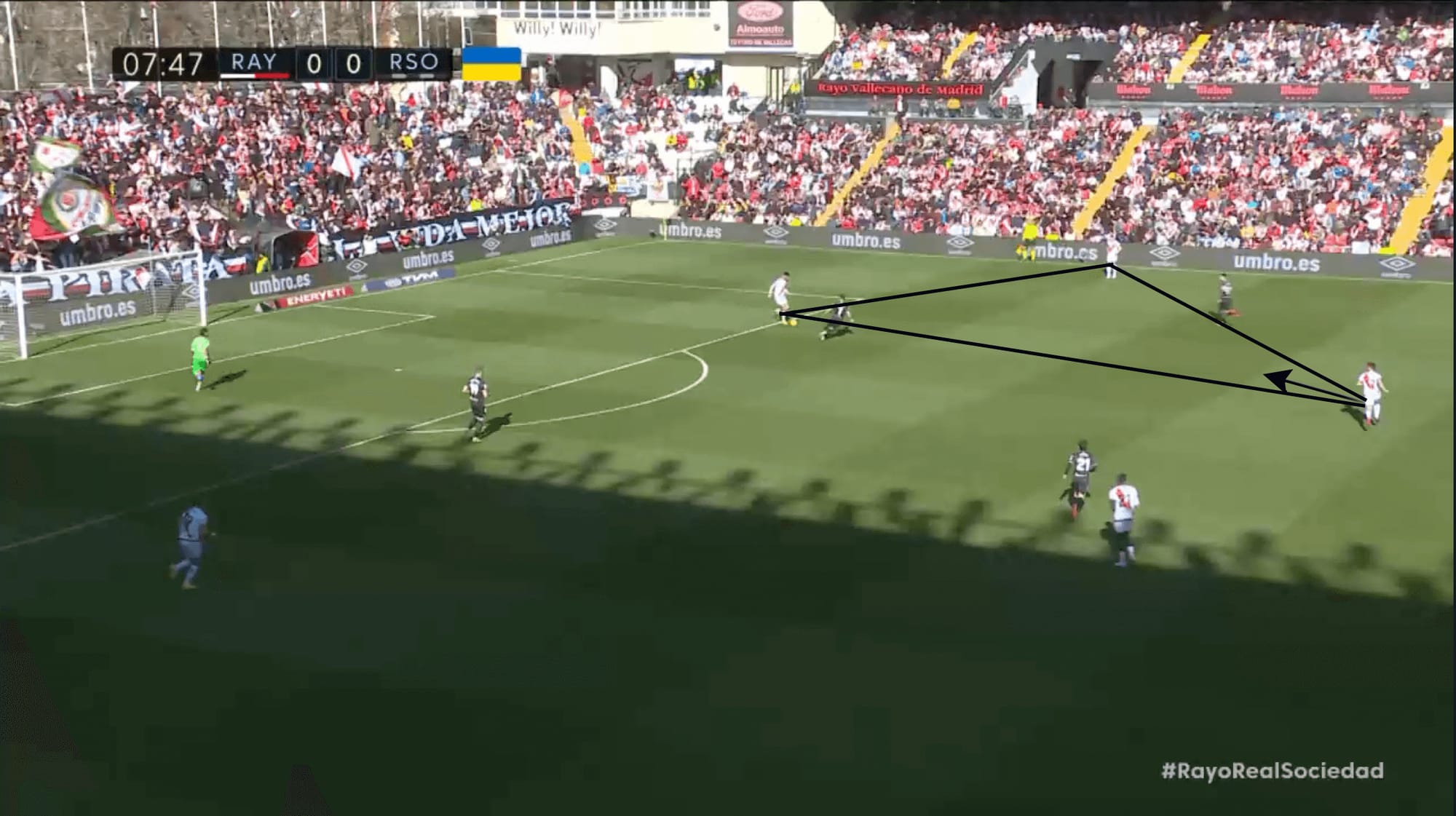
After Catena plays the pass to the midfielder, he is able to find García with the left-back, then carries the ball into the space ahead of him. Under Iraola, it is clear to see that players looked to position themselves in a manner that allowed them to provide each other with angles of support and in situations in which they had good angles as well as space, they would not hesitate to progress the ball through the thirds with combination play.
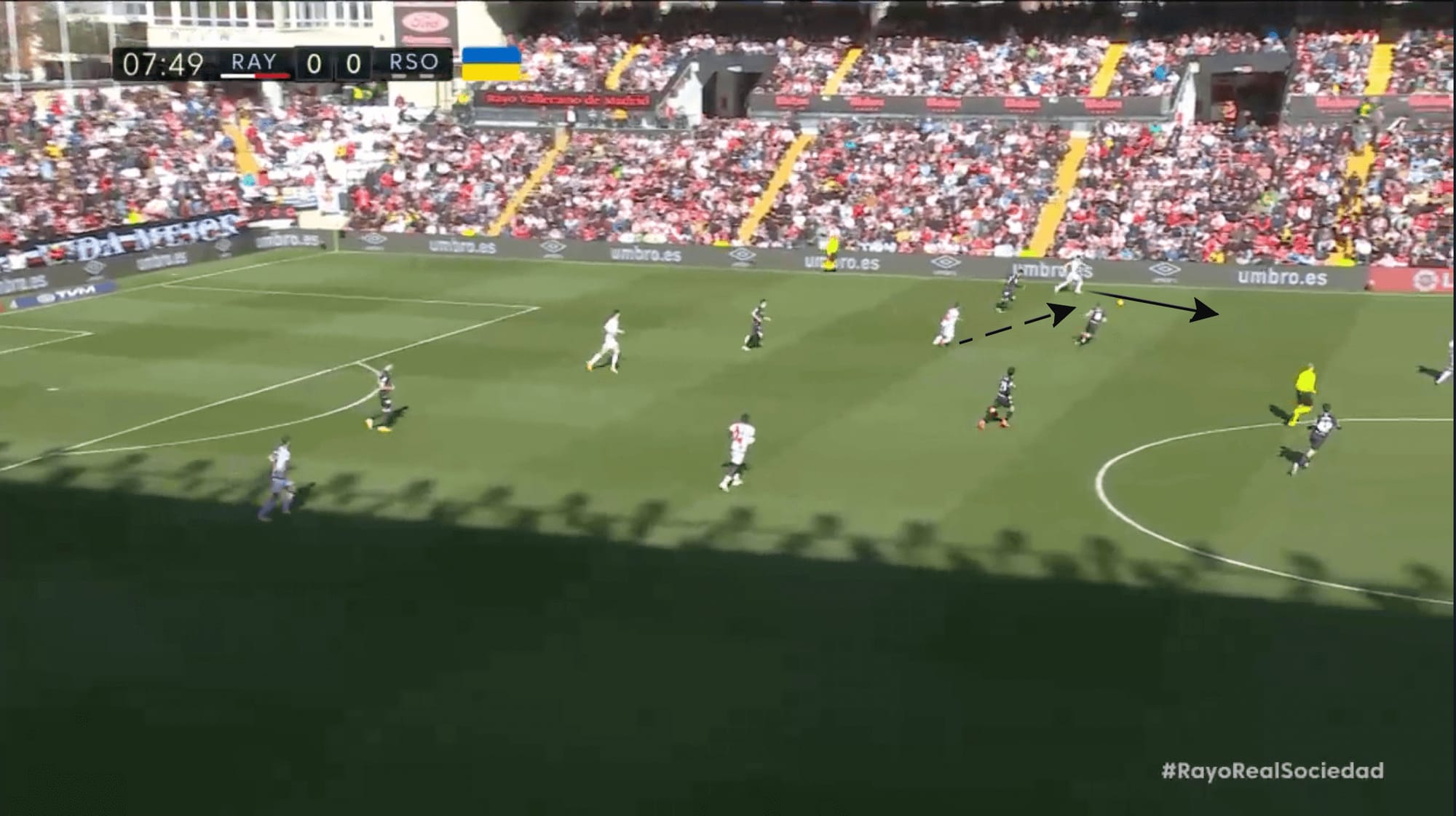
Although capable of creating good supporting angles and utilising this aspect and space to progress the ball, Vallecano under Iraola did not try and do this even when they had opportunities to do so. As shown below in the example, García is in possession of the ball on the left-hand side, with López providing him with support and Óscar Trejo in the attacking midfield position.
In this particular scenario, Vallecano are well positioned and have adequate space in order to create a 4v3 overload against the opposition players. However, García would elect to play a lofted ball over the top to the winger, Álvaro García. This is something Vallecano would often do in order to utilise the speed of Álvaro García to exploit opposition defences.
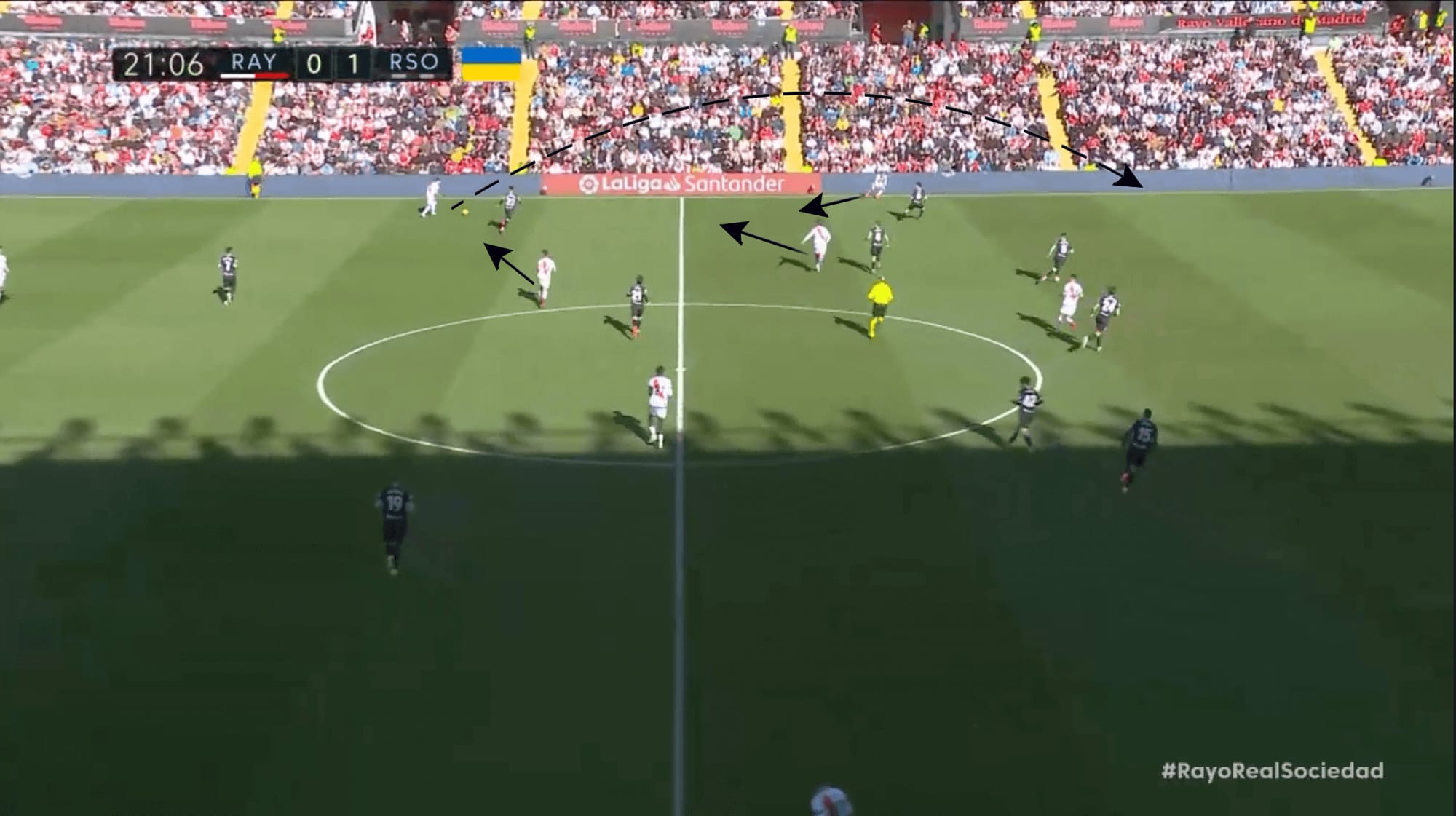
This is something that was executed not just by the left full-back García but by the other centre-backs as well as the goalkeeper. This can be seen in the example below, with Catena choosing to play a long ball, even with García to his left and López in a position where he can support both the centre-back and the full-back.
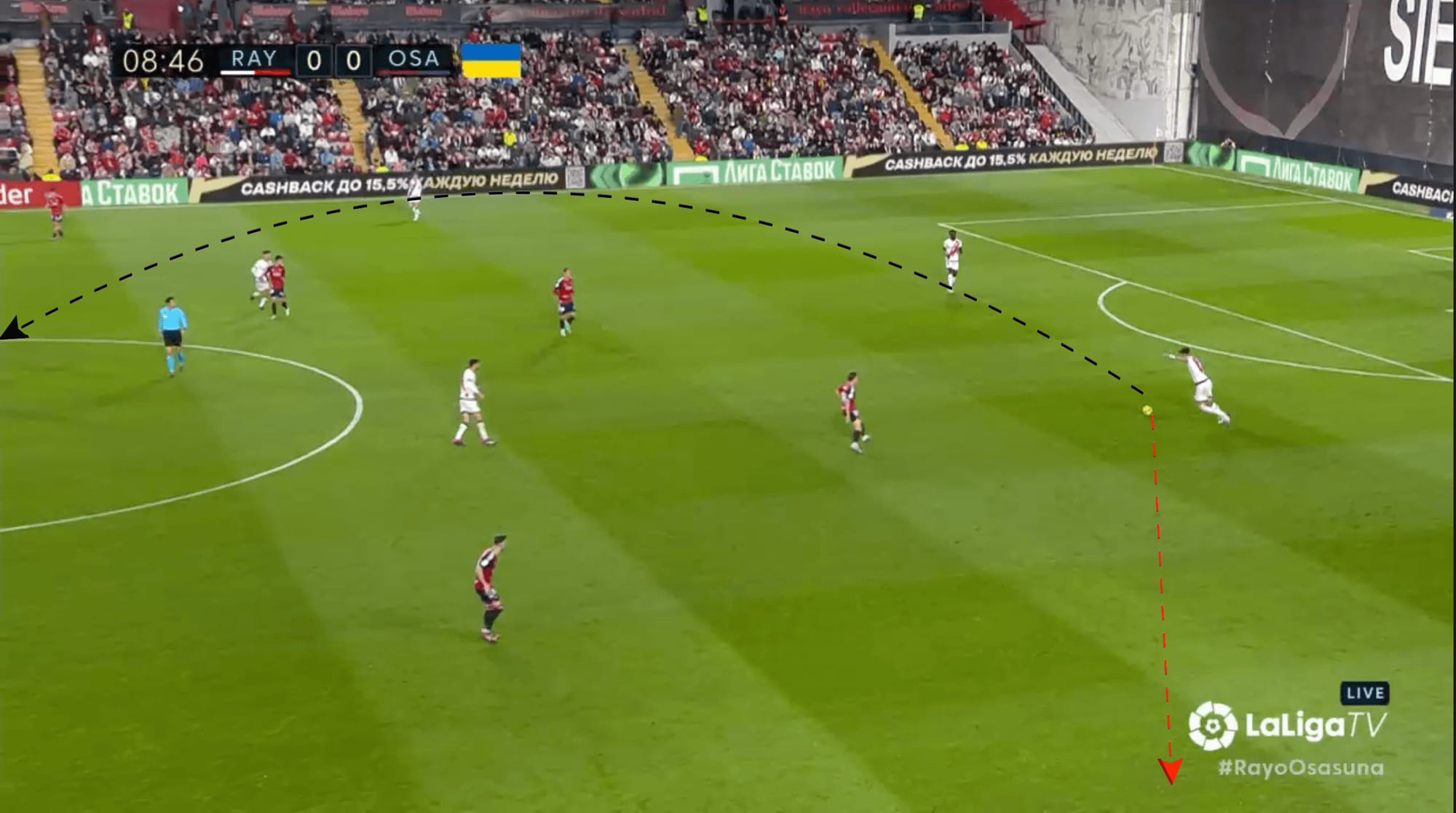
This method of playing the ball in behind to Álvaro Garcí has the potential of creating two beneficial situations for Vallecano. The first is that it can directly get the winger through on goal and thus instantly create a goal-scoring opportunity, or it can create 1v1 situations against the opposition right-back.
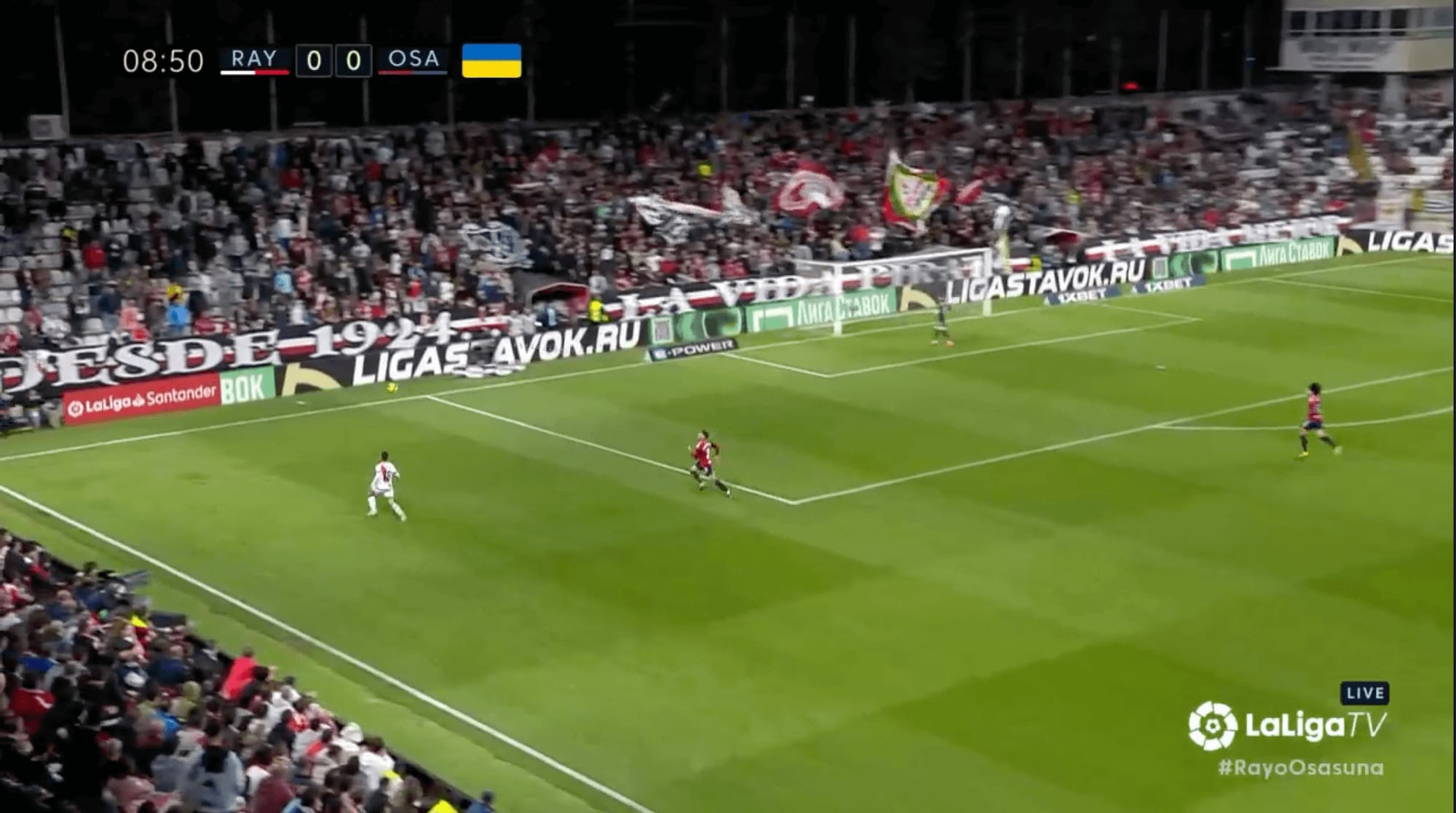
However, Vallecano do not just look to get García in these situations, with their midfielders occasionally attacking the last line. This aspect of Vallecano’s game last season requires the ability to recognise when cover has been reduced in the back line of the opposition’s defence. As can be seen in the example below, Isi Palazón drops slightly deeper to receive the ball, and as a result, the opposition full-back begins to track the movement of the winger.

Because of this, space is created in the back line, which the midfielder, Santi Comesaña, looks to attack and exploit, with the long ball played into the space between the opposition players.
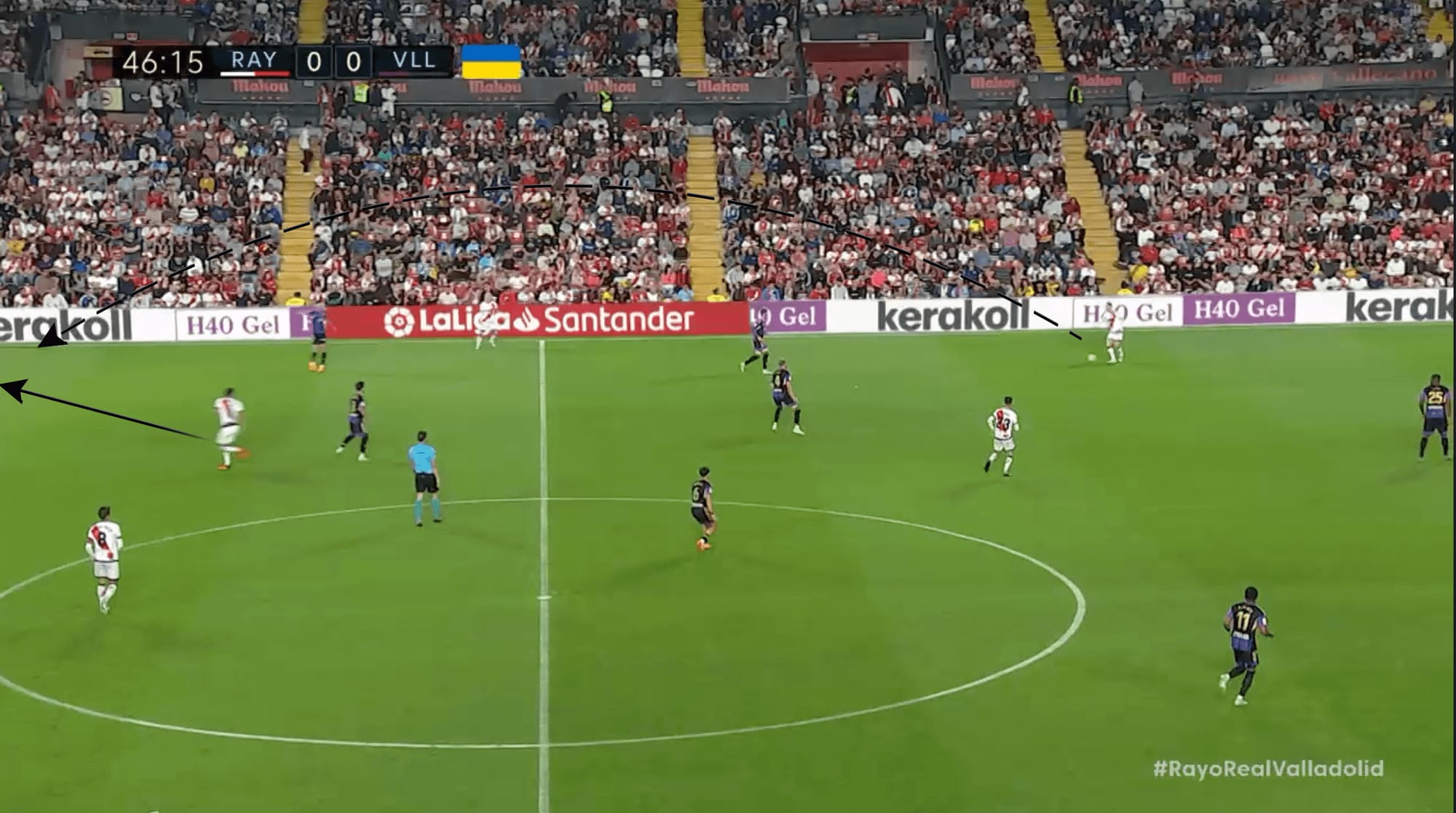
In the final third, however, Vallecano would centre the majority of their attacks down the wide areas, particularly on the left-hand side. In these areas, it would not be uncommon for one of the central midfielders to drift towards the wide areas in order to support the left full-back and the left winger.
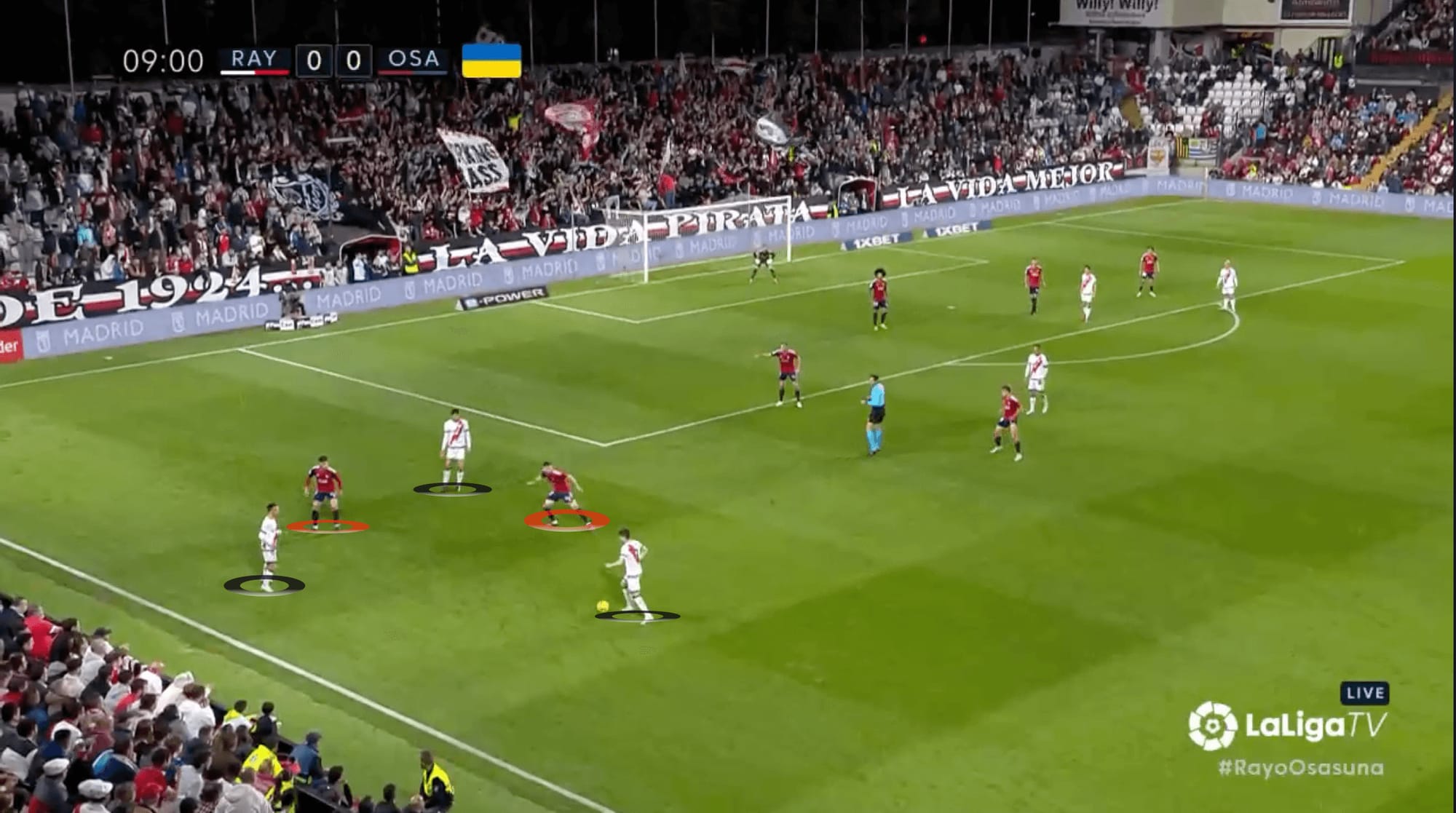
In these situations, Vallecano could create numerical advantages against opposition players, using space and creating good passing angles to create shooting, crossing and cut-back opportunities.
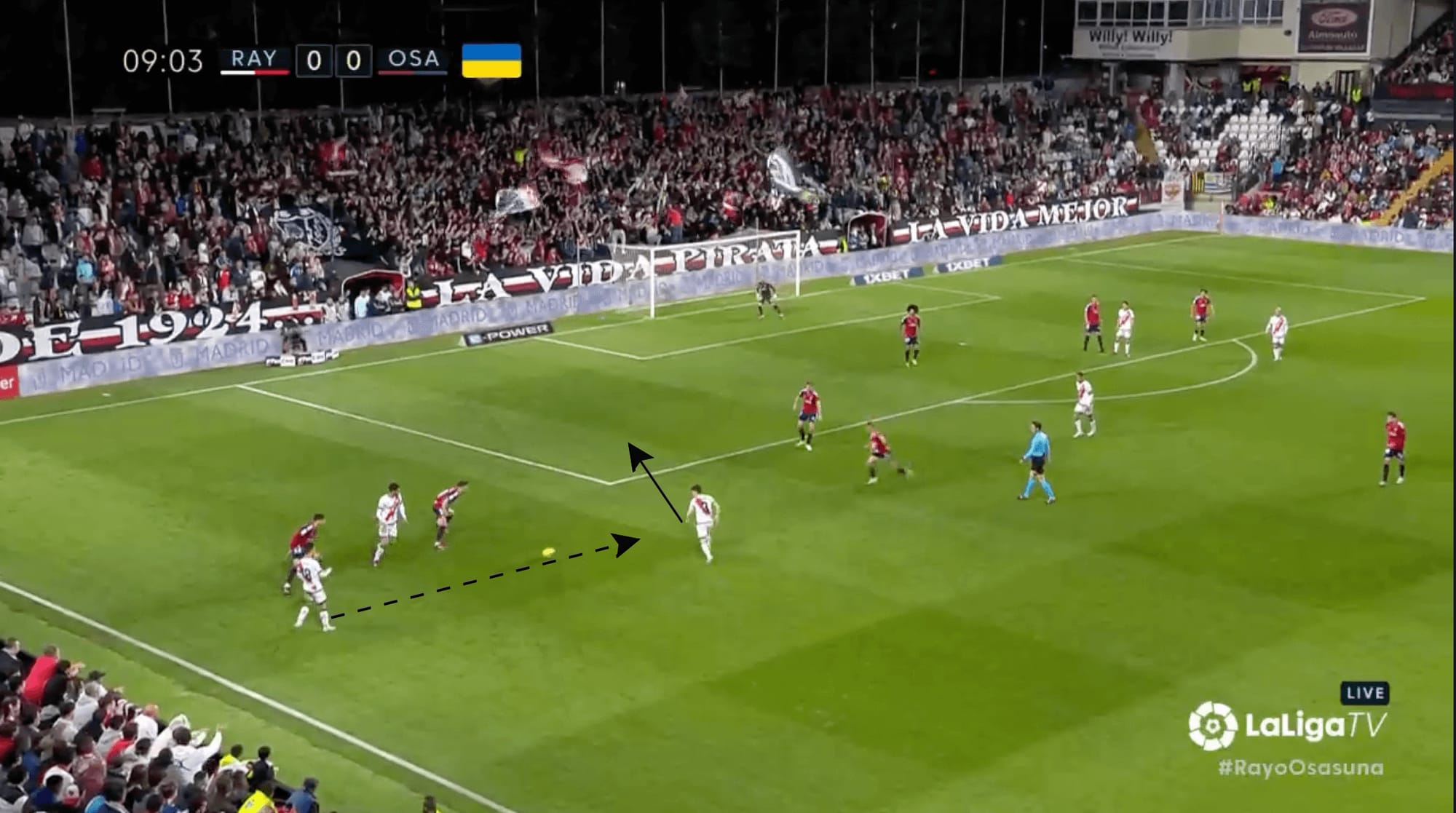
Another example of this can be seen in the image below, this time with Trejo also moving towards the wide areas to support the full-back and the winger, initially creating a 4v3 in the wide area.
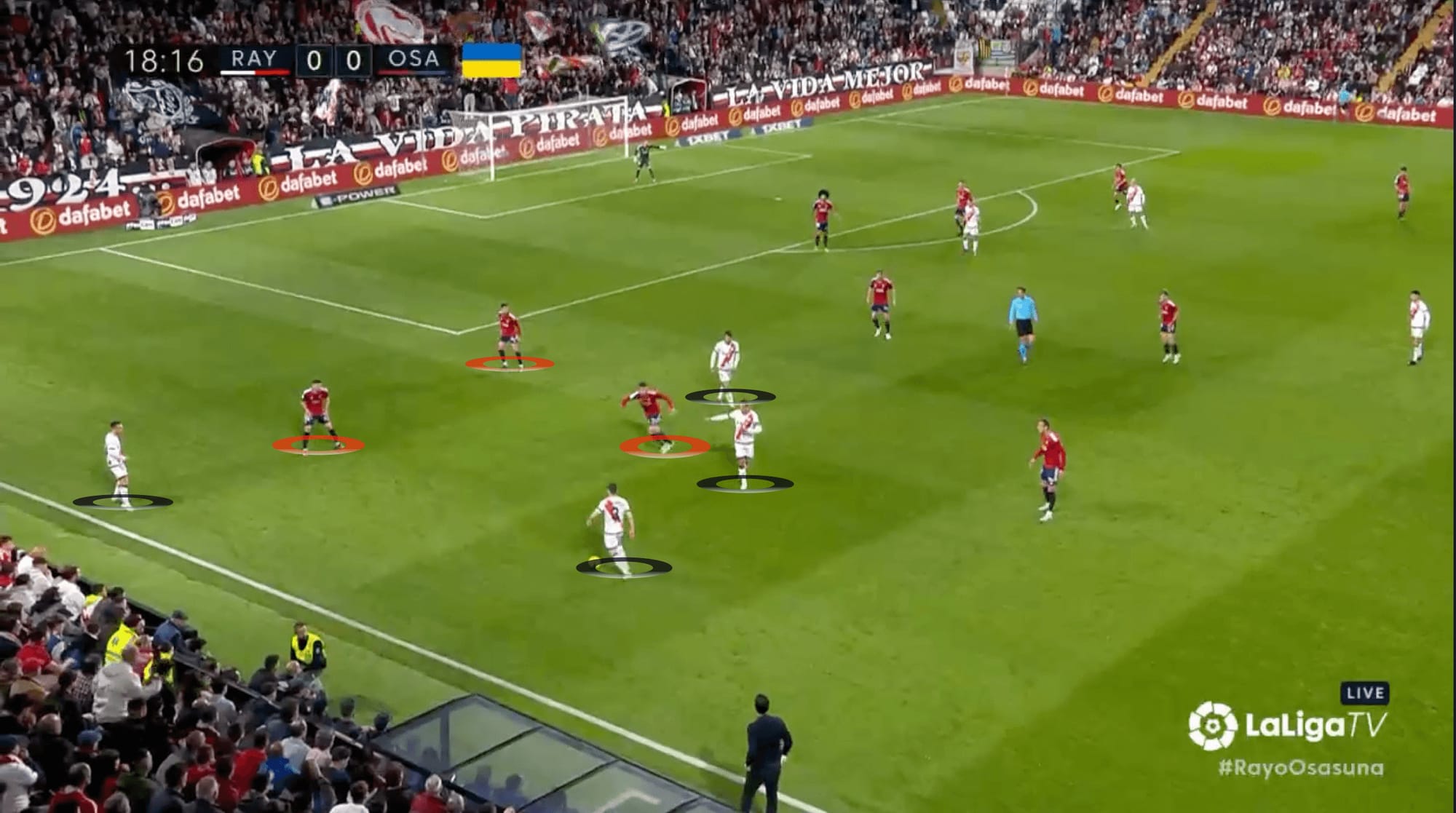
Once again, Vallecano could utilise the space well and continually move to create even more space for others and create good passing angles, allowing them to combine and exploit the holes in the opposition’s defence.
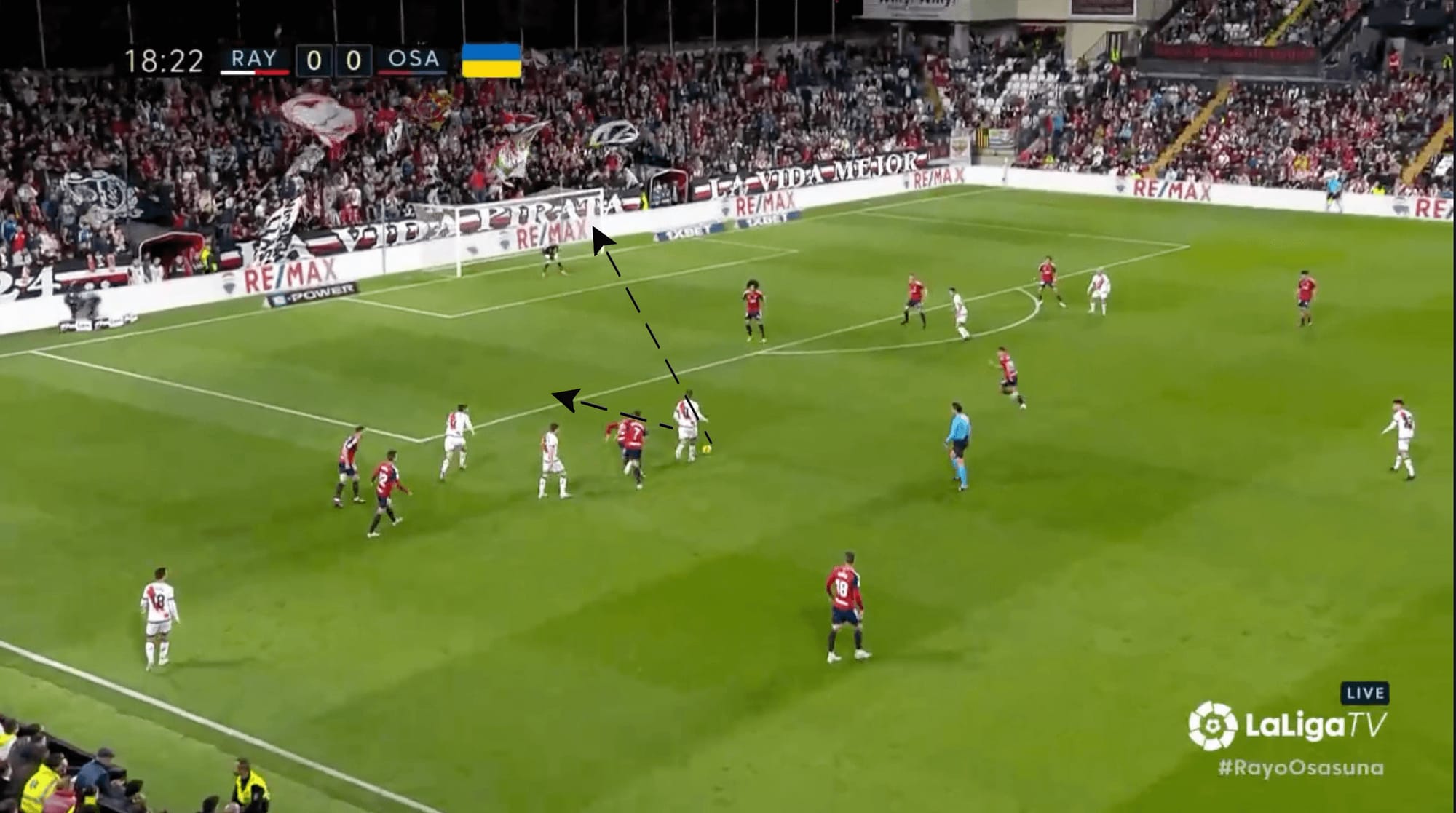
How has the side changed?
Vallecano, this season under Francisco, are even more direct in the attacking phase of the game, with the side again looking to attack down the flanks, particularly the left-hand side, to create crossing opportunities.
As mentioned earlier, the side structure is geared towards more direct football, with players, especially the midfielders not close to each other. What is also significantly different is the full-backs’ positions, even in the earlier stages of build-up. The side have turned their focus to overloading the last line of defence and using Álvaro García to invert, dragging the opposition full-back further infield, whilst Alfonso Espino, the left full-back, advances down the line. In these situations, the centre-backs will not hesitate to play long balls to players on the last line of defence.
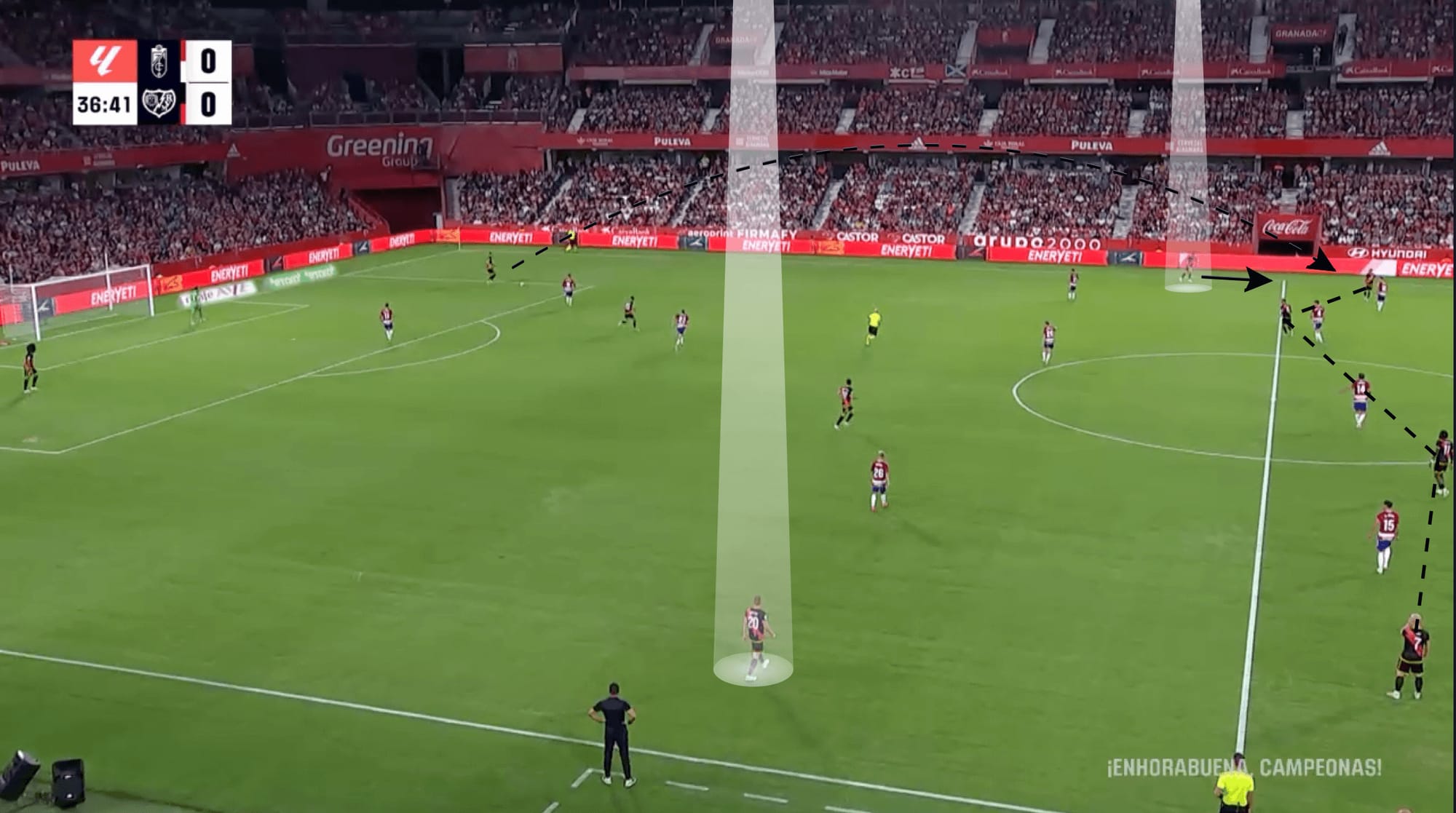
Vallecano, under Francisco, look to play the ball towards the last line and play towards the last line quickly. Because of this, the ball is sometimes played forward, with the side not in a position to sustain attacks or defend opposition counters. This can be seen in the example below, where Vallecano immediately looks to play the ball to García on the left-hand side rather than consolidate possession shortly after winning the ball.
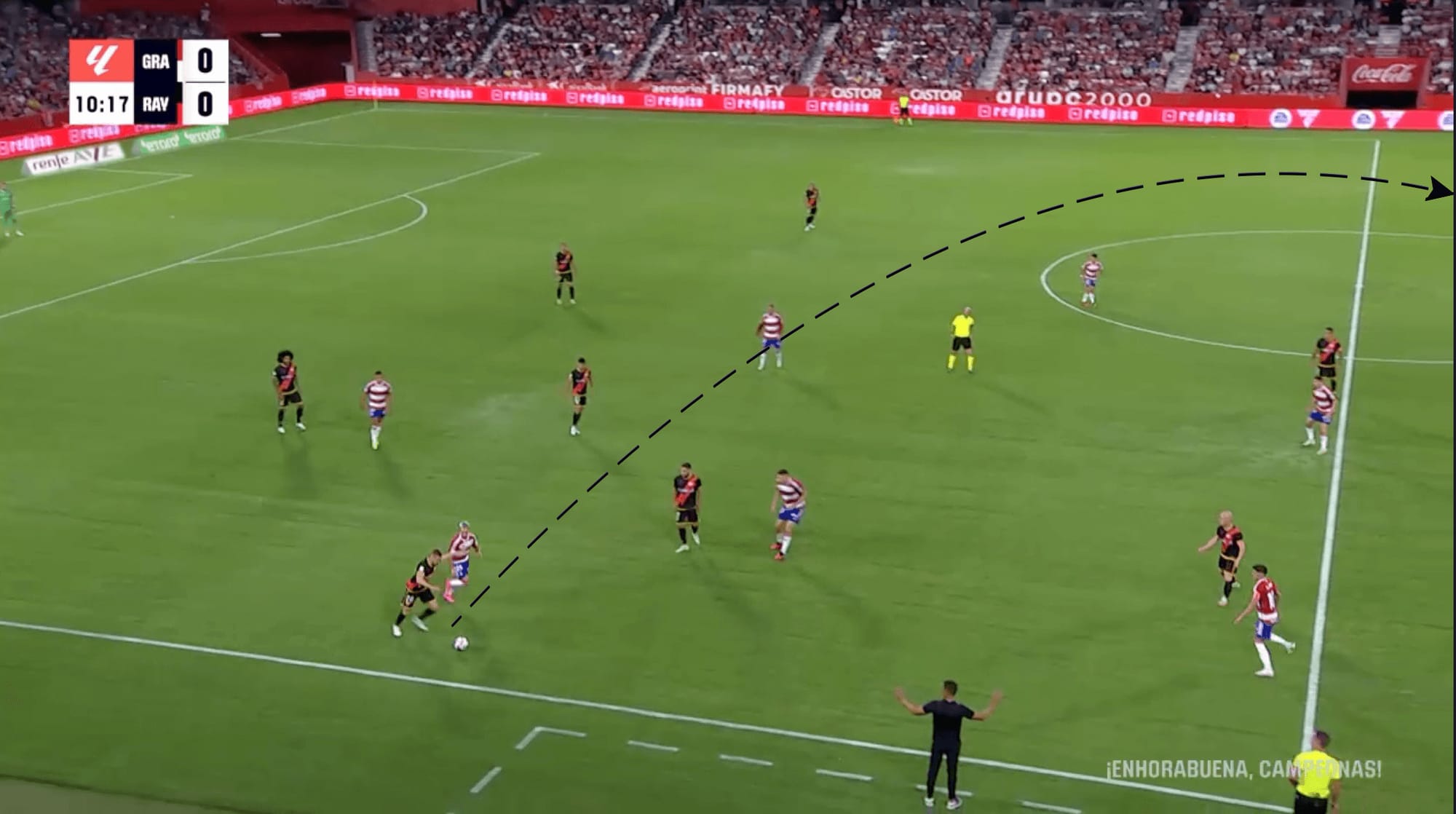
With García not ready to attack, this would result in Vallecano losing the ball.
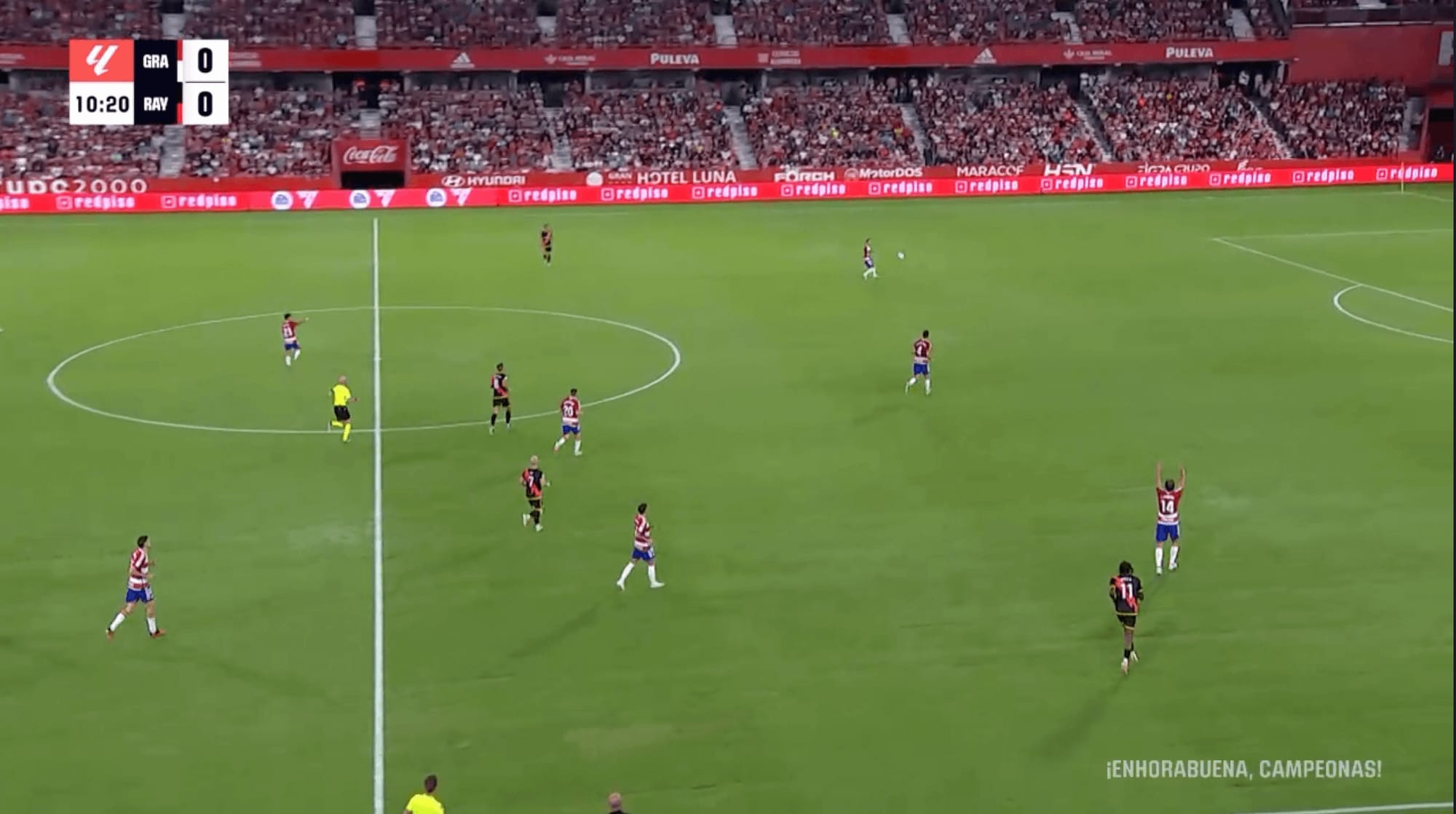
Because of their game’s fast-paced and direct nature, opposition teams face a game with many duels, with Vallecno challenging for first, second, and third balls with high intensity. This, without a doubt, can unsettle opposition teams and prevent them from establishing any sort of rhythm.
This can be seen in the example below, with the opposition defender intercepting a Vallecano long ball, but with Veallecano attackers descending on him with speed, he has no time to bring the ball down and heads the ball back in the other direction.
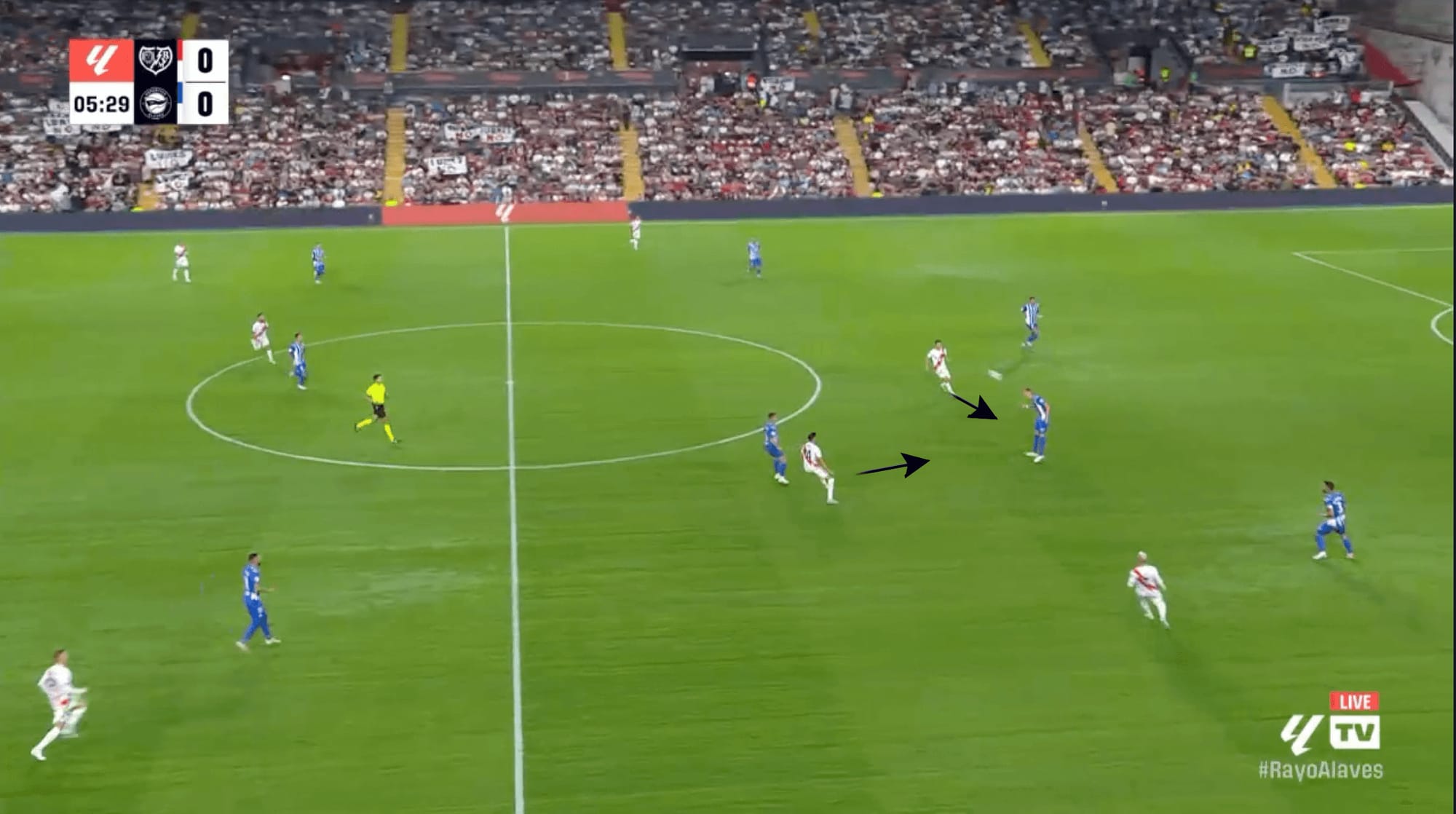
But as can be seen in the image below, Rayo Vallecano players are positioned well to challenge for the second ball and force a poor touch from the opposition player. However, Vallecano are not always positioned this well after long balls, especially in cases where many of their players have advanced to the last line of the defence.
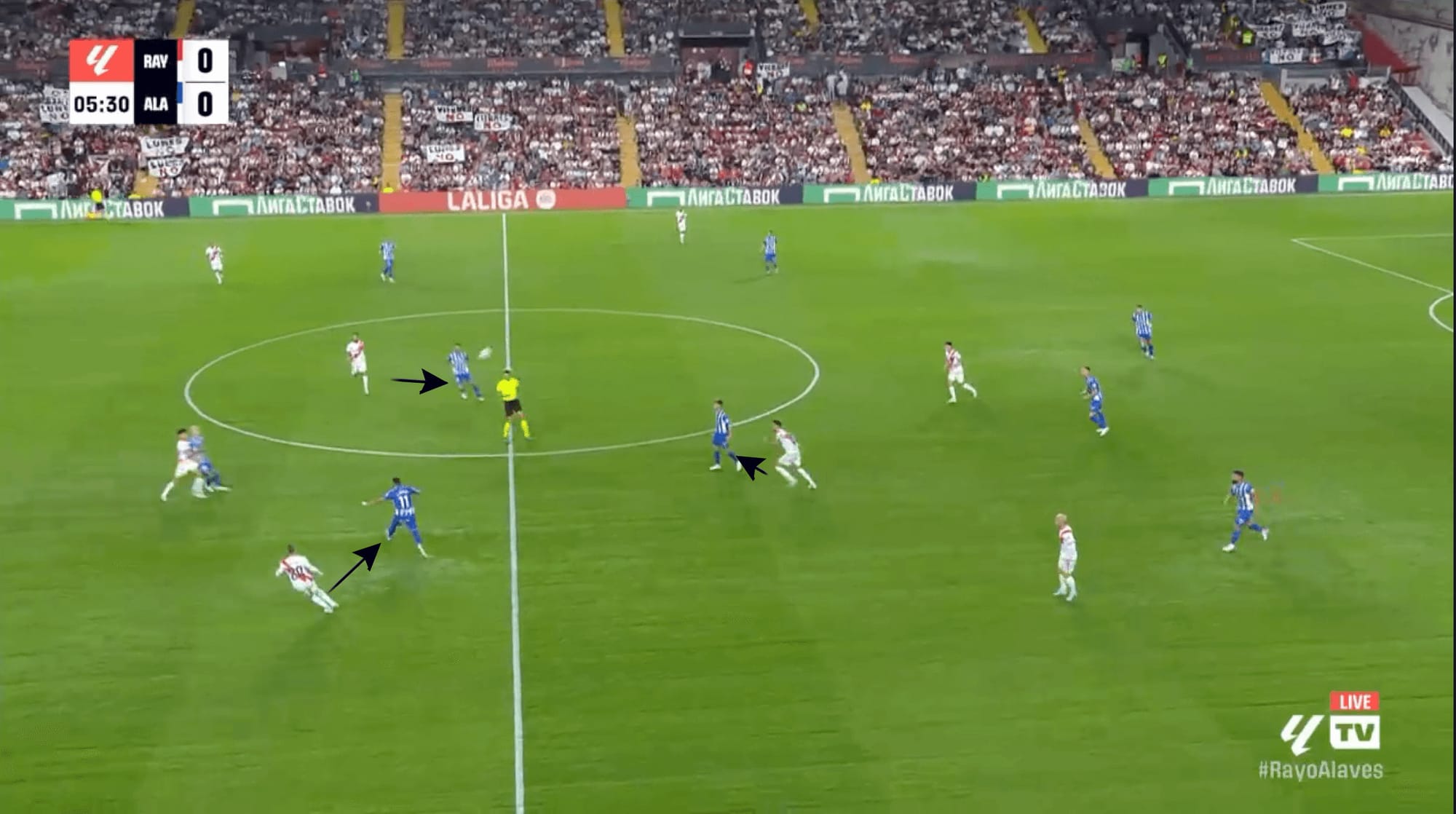
The image below is from an example that has already been used in this piece but shows the events that took place shortly after. A long ball is played to Gracía from the back line, with the winger failing to control the ball or play in any of his teammates.
As a result, Granada cannot win back possession, and due to the spaced-out positioning of the side, there are not many players in close proximity to the second ball to challenge for it.
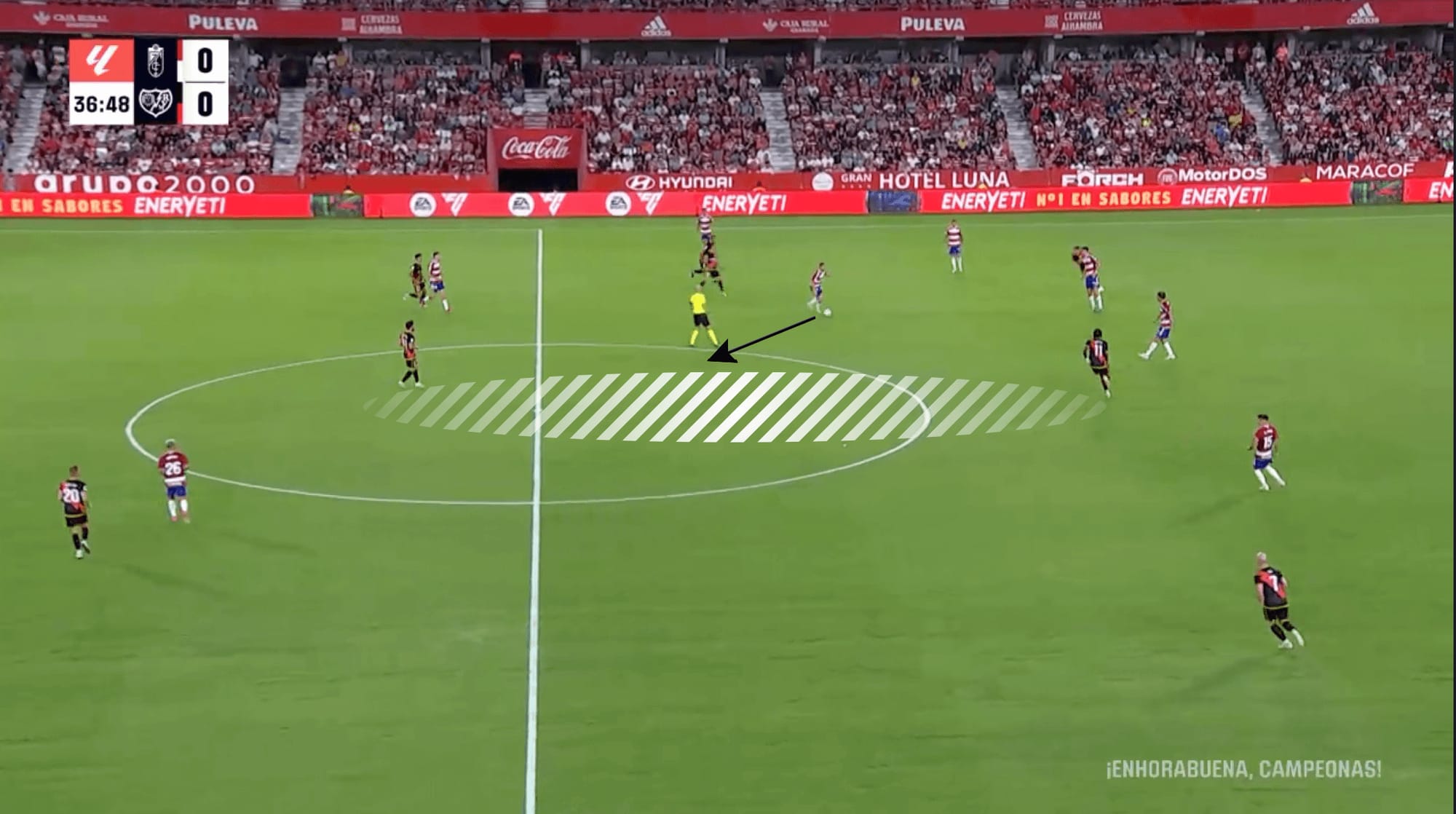
In the final third, Vallecano this season have looked to act quickly, with players looking to play the ball into the box as soon as possible. A common rotation that can be seen to get them into these positions is García inverting into the pitch and dragging the defender whilst Espino advances forward.
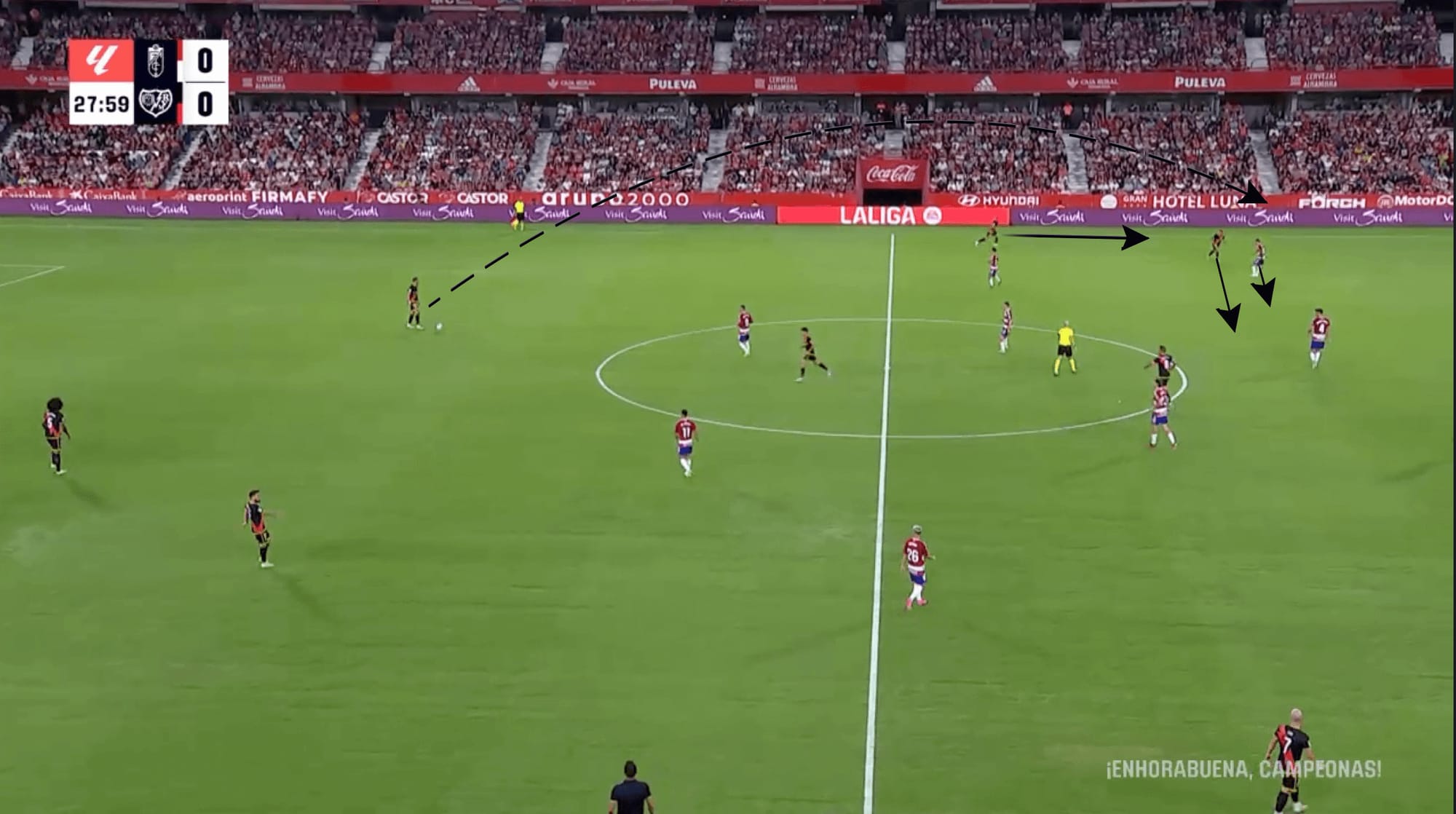
This allows the side to create 2v1s against opposition full-backs and potentially create crossing opportunities.
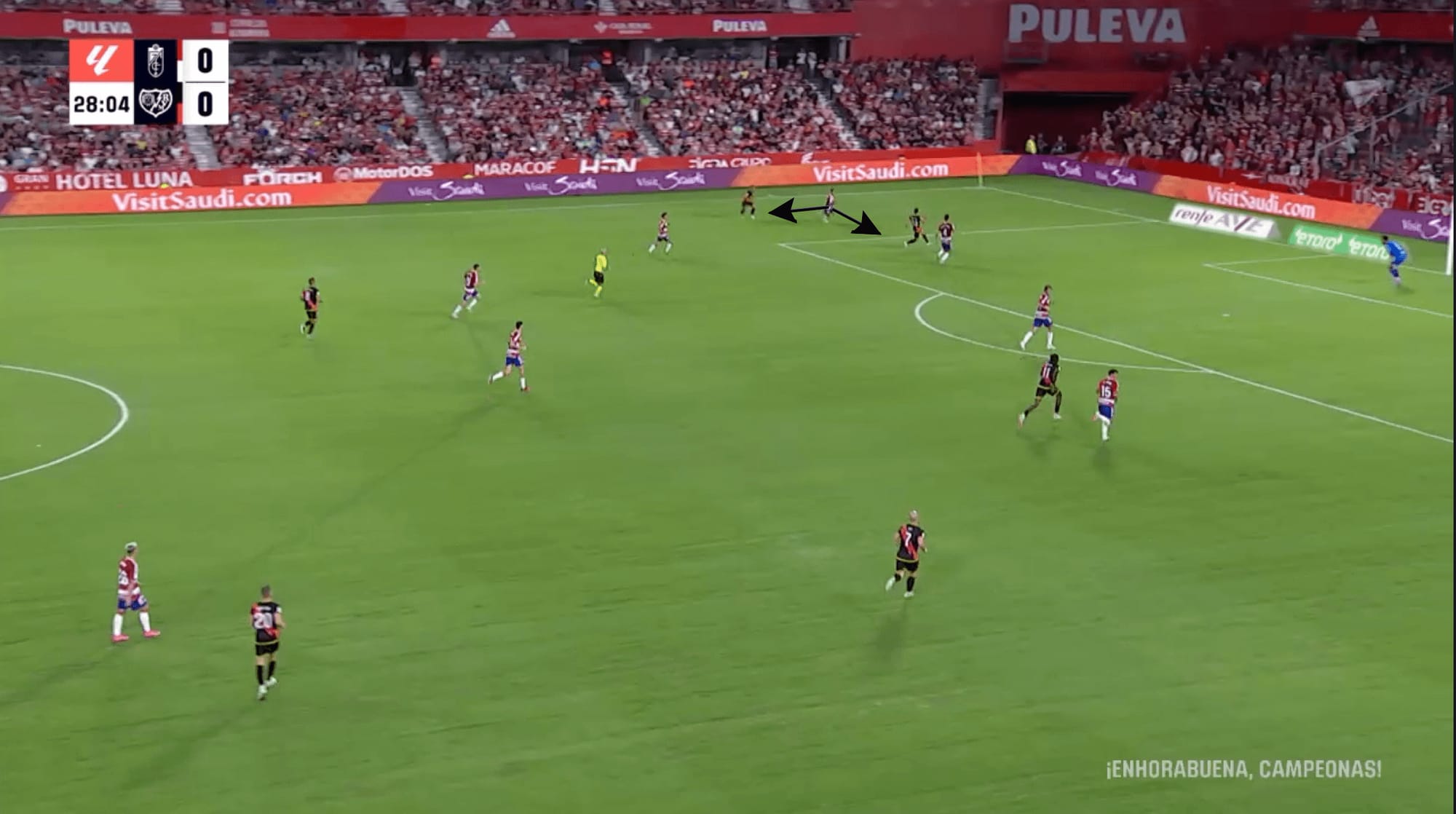
However, this inversion into central areas is somewhat flexible, as can be seen in the example below, with Espino this time moving into a more central area, whilst García stays on the touchline. As a result, the distance between the opposition full-back and centre-back is increased, and Espino looks to exploit this space.
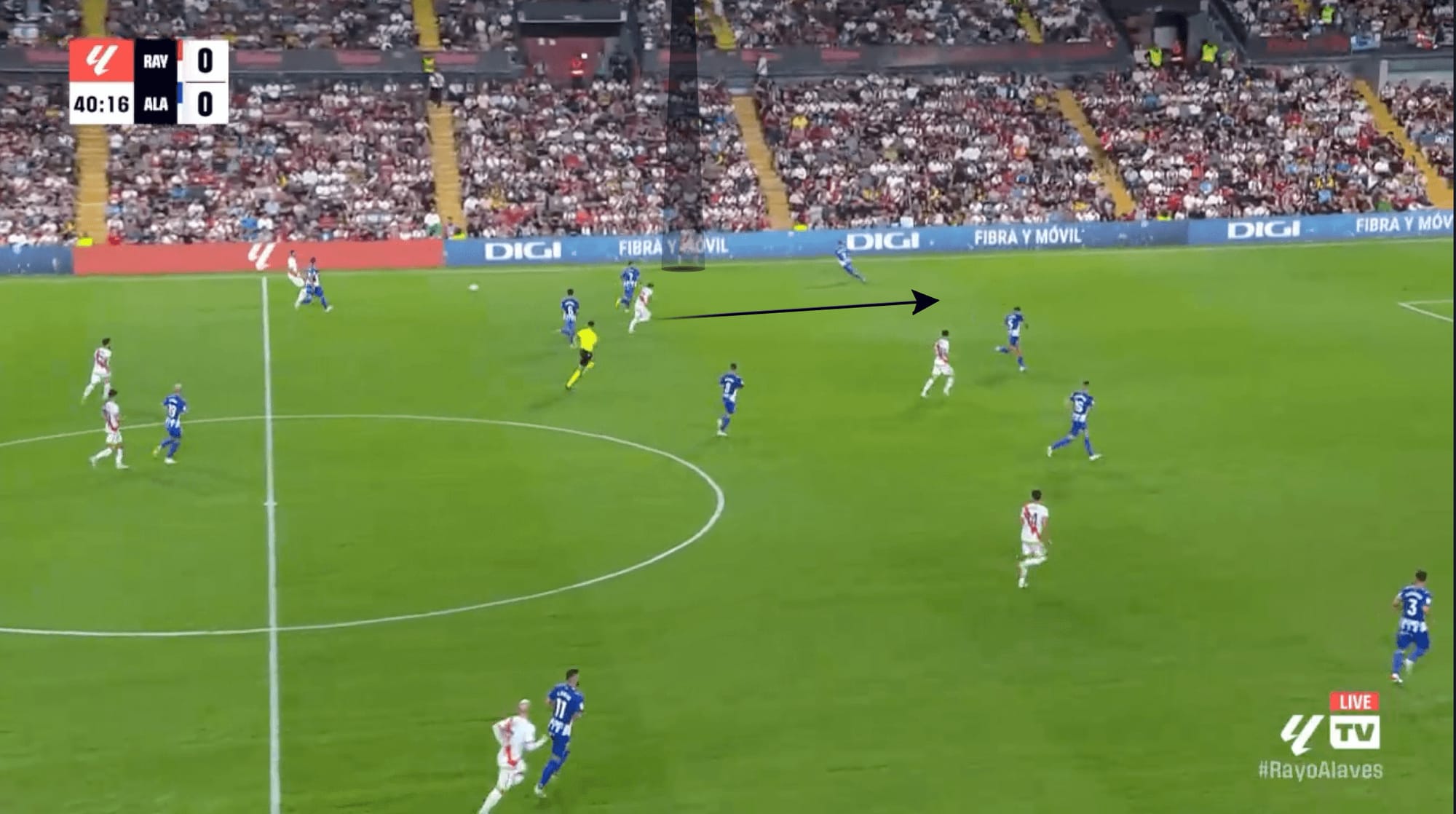
Espino would then receive the ball, which would, in turn, force the opposition centre-back to move towards the wide areas and engage with the full-back.

After, the ball would fortuitously ricochet off the defender and land at the feet of García, who could burst into the box and win a penalty. Although slightly lucky, the side put themselves in a position to exploit spaces in the last defensive line and combine this with high-intensity support, which allows them to create further chaos for the opposition team’s final defensive line.
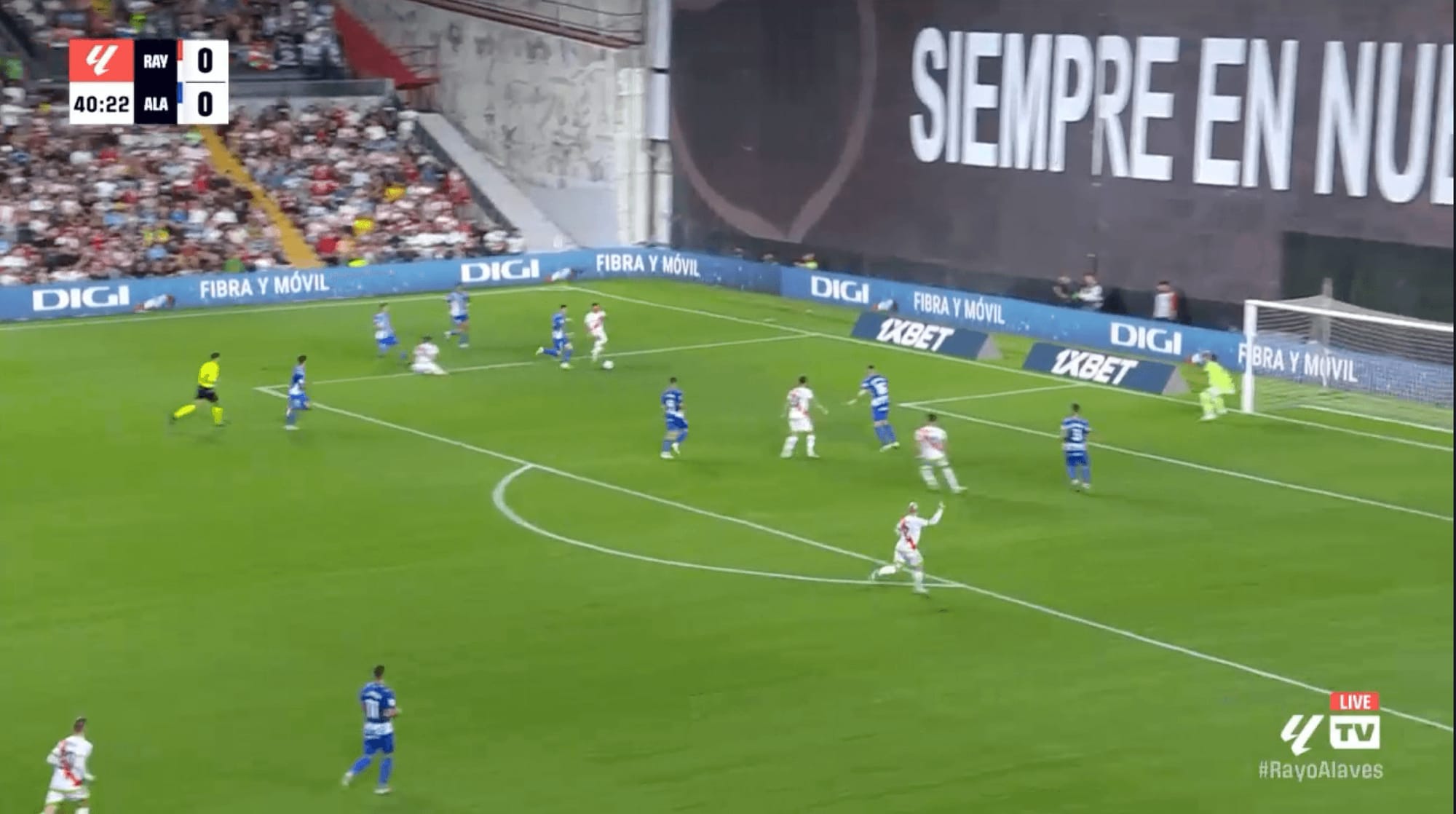
Conclusion
The season is still very young, but at this point, Rayo Vallecano are once again establishing themselves as a side that is very tricky to play against.
Their football has become slightly more direct than it was last season, as this analysis shows, with this not necessarily being inherently bad. However, at times, the side could benefit from slowing the game down and putting themselves in better positions to defend transitions. Additionally, the nature of their attack can sometimes seem attritional, which does bring its own advantages. Still, more patterns of play could be developed to get the side into positions where they can create good chances consistently.





Comments